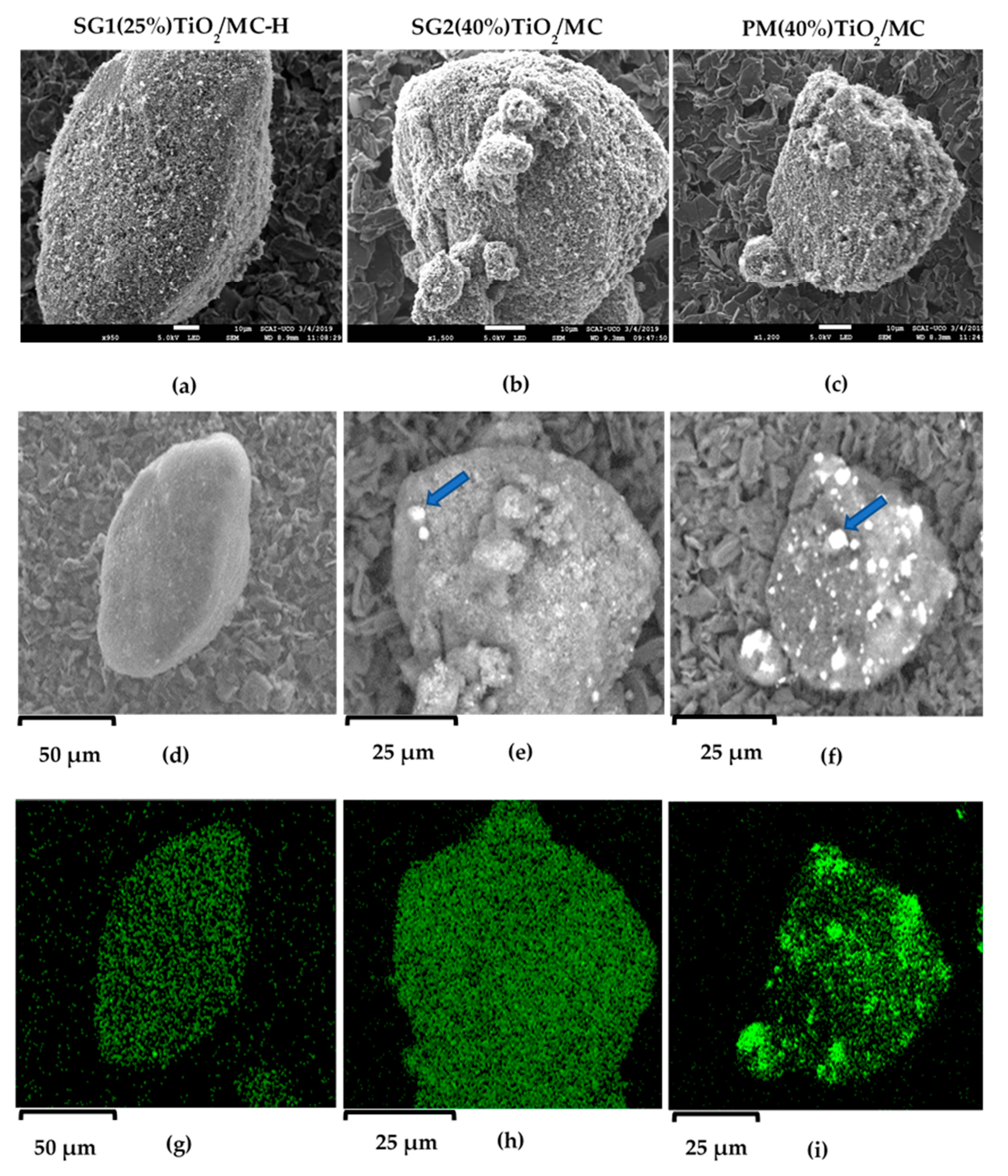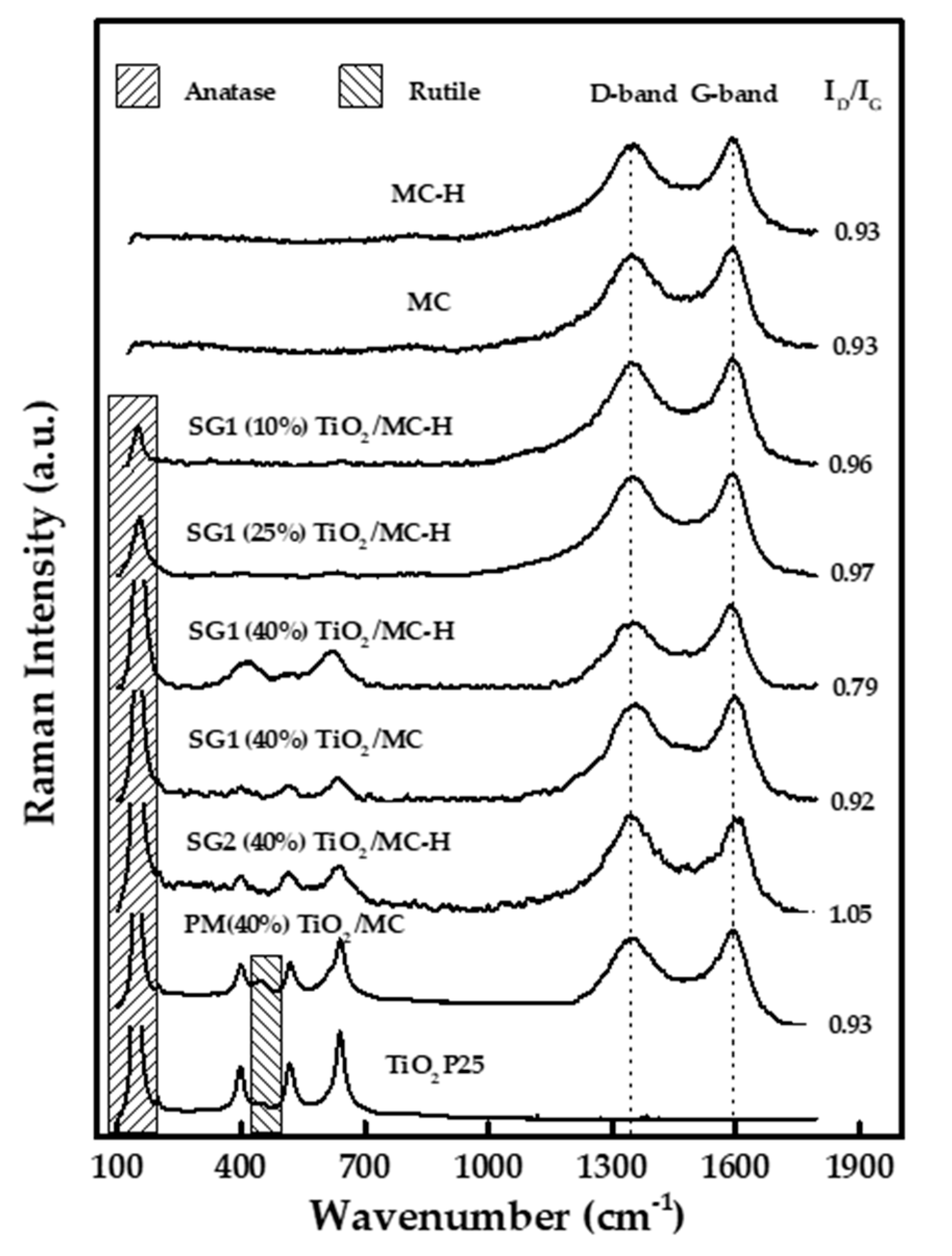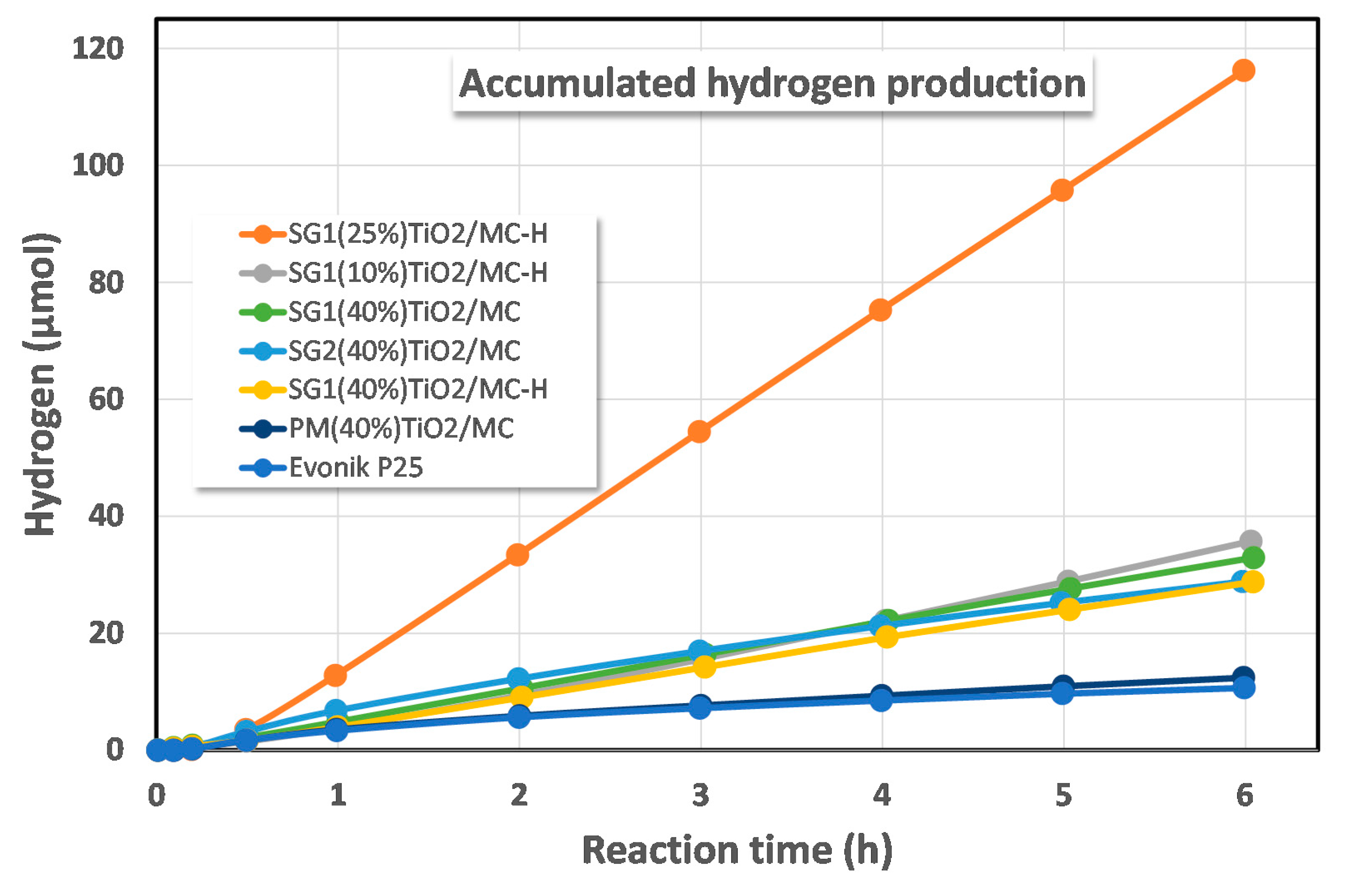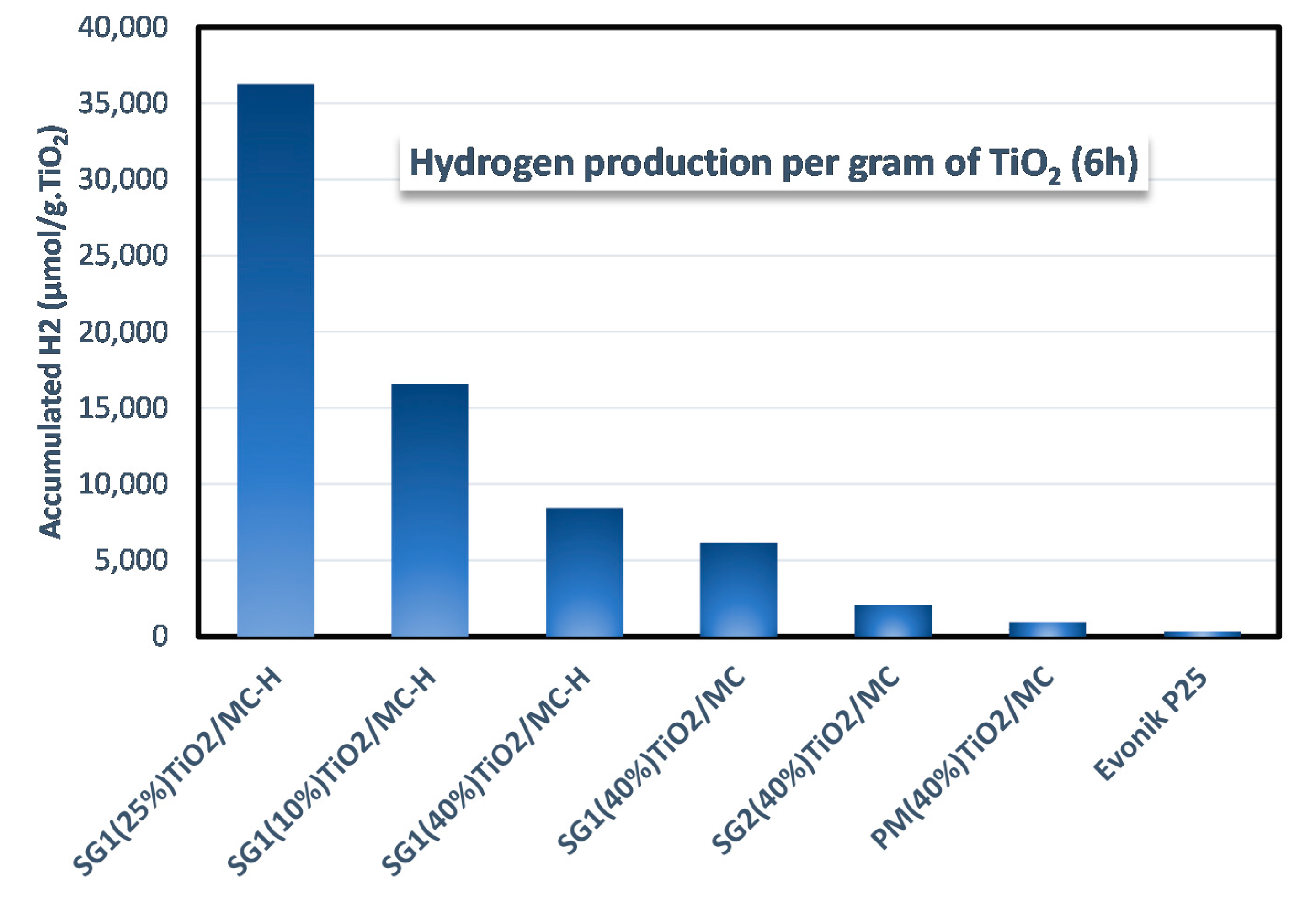Hydrogen Production through Glycerol Photoreforming on TiO2/Mesoporous Carbon: Influence of the Synthetic Method
Abstract
:1. Introduction
2. Materials and Methods
2.1. Materials
2.2. Synthesis of the Photocatalysts
2.2.1. Mesoporous Carbon Functionalization (MC-H)
2.2.2. Physical Mixture Synthetic Method (PM)
2.2.3. Ultrasound-Assisted Sol-Gel Synthetic Method (SG1)
2.2.4. Water-Assisted Sol-Gel Synthetic Method (SG2)
2.3. Catalyst Characterization
2.4. Photocatalytic Hydrogen Production
3. Results
3.1. Functionalization of MC to Obtain MC-H Solid
3.2. Characterization of TiO2/MC Catalysts
3.2.1. Chemical Composition
3.2.2. N2 Adsorption/Desorption Isotherms
3.2.3. SEM Micrographs
3.2.4. X-ray Diffraction
3.2.5. Raman Spectroscopy
3.2.6. FT-IR Spectroscopy
3.2.7. UV-Vis Spectroscopy
3.2.8. Glycerol Photoreforming
4. Conclusions
Supplementary Materials
Author Contributions
Funding
Acknowledgments
Conflicts of Interest
References
- Dawood, F.; Anda, M.; Shafiullah, G.M. Hydrogen production for energy: An overview. Int. J. Hydrogen Energy 2020, 45, 3847–3869. [Google Scholar] [CrossRef]
- International Energy Agency. The Latest Trends in Energy and Emissions in 2018; Global Energy & CO2 Status Report 2019; International Energy Agency: Paris, France, 2019; Available online: https://www.iea.org/reports/global-energy-co2-status-report-2019 (accessed on 20 August 2020).
- Martins, F.; Felgueiras, C.; Smitkova, M.; Caetano, N. Analysis of fossil fuel energy consumption and environmental impacts in European countries. Energies 2019, 12, 964. [Google Scholar] [CrossRef] [Green Version]
- Chapman, A.; Itaoka, K.; Farabi-Asl, H.; Fujii, Y.; Nakahara, M. Societal penetration of hydrogen into the future energy system: Impacts of policy, technology and carbon targets. Int. J. Hydrog. Energy 2020, 45, 3883–3898. [Google Scholar] [CrossRef]
- Chandrasekhar, K.; Lee, Y.J.; Lee, D.W. Biohydrogen production: Strategies to improve process efficiency through microbial routes. Int. J. Mol. Sci. 2015, 16, 8266–8293. [Google Scholar] [CrossRef] [PubMed] [Green Version]
- Muradov, N.Z.; Veziroǧlu, T.N. From hydrocarbon to hydrogen-carbon to hydrogen economy. Int. J. Hydrogen Energy 2005, 30, 225–237. [Google Scholar] [CrossRef]
- Bowker, M. Photocatalytic hydrogen production and oxygenate photoreforming. Catal. Lett. 2012, 142, 923–929. [Google Scholar] [CrossRef]
- Bahruji, H.; Bowker, M.; Davies, P.R.; Pedrono, F. New insights into the mechanism of photocatalytic reforming on Pd/TiO2. Appl. Catal. B Environ. 2011, 107, 205–209. [Google Scholar] [CrossRef]
- López-Tenllado, F.J.; Hidalgo-Carrillo, J.; Montes, V.; Marinas, A.; Urbano, F.J.; Marinas, J.M.; Ilieva, L.; Tabakova, T.; Reid, F. A comparative study of hydrogen photocatalytic production from glycerol and propan-2-ol on M/TiO2 systems (M = Au, Pt, Pd). Catal. Today 2017, 280, 58–64. [Google Scholar] [CrossRef]
- Carp, O.; Huisman, C.L.; Reller, A. Photoinduced reactivity of titanium dioxide. Prog. Solid State Chem. 2004, 32, 33–177. [Google Scholar] [CrossRef]
- Tahir, M.; Amin, N.S. Indium-doped TiO2 nanoparticles for photocatalytic CO2 reduction with H2O vapors to CH4. Appl. Catal. B Environ. 2015, 162, 98–109. [Google Scholar] [CrossRef]
- Sharma, A.; Liu, N.; Ma, Q.; Zheng, H.; Kawazoe, N.; Chen, G.; Yang, Y. PEG assisted P/Ag/Ag2O/Ag3PO4/TiO2 photocatalyst with enhanced elimination of emerging organic pollutants in salinity condition under solar light illumination. Chem. Eng. J. 2020, 385, 123765. [Google Scholar] [CrossRef]
- Malengreaux, C.M.; Pirard, S.L.; Léonard, G.; Mahy, J.G.; Herlitschke, M.; Klobes, B.; Hermann, R.; Heinrichs, B.; Bartlett, J.R. Study of the photocatalytic activity of Fe3+, Cr3+, La3+ and Eu3+ single-doped and co-doped TiO2 catalysts produced by aqueous sol-gel processing. J. Alloy. Compd. 2017, 691, 726–738. [Google Scholar] [CrossRef] [Green Version]
- Hsieh, C.-T.; Fan, W.-S.; Chen, W.-Y.; Lin, J.-Y. Adsorption and visible-light-derived photocatalytic kinetics of organic dye on Co-doped titania nanotubes prepared by hydrothermal synthesis. Sep. Purif. Technol. 2009, 67, 312–318. [Google Scholar] [CrossRef]
- Abdullah, H.; Khan, M.M.R.; Ong, H.R.; Yaakob, Z. Modified TiO2 photocatalyst for CO2 photocatalytic reduction: An overview. J. CO2 Util. 2017, 22, 15–32. [Google Scholar] [CrossRef]
- Szkoda, M.; Siuzdak, K.; Lisowska-Oleksiak, A. Non-metal doped TiO2 nanotube arrays for high efficiency photocatalytic decomposition of organic species in water. Phys. E Low Dimens. Syst. Nanostruct. 2016, 84, 141–145. [Google Scholar] [CrossRef]
- Lin, H.Y.; Shih, C.Y. Efficient one-pot microwave-assisted hydrothermal synthesis of M (M = Cr, Ni, Cu, Nb) and nitrogen co-doped TiO2 for hydrogen production by photocatalytic water splitting. J. Mol. Catal. A Chem. 2015, 411, 128–137. [Google Scholar] [CrossRef]
- Gaikwad, P.N.; Hankare, P.P.; Wandre, T.M.; Garadkar, K.M.; Sasikala, R. Photocatalytic performance of magnetically separable Fe, N co-doped TiO2-cobalt ferrite nanocomposite. Mater. Sci. Eng. B Solid-State Mater. Adv. Technol. 2016, 205, 40–45. [Google Scholar] [CrossRef]
- Liu, D.N.; He, G.H.; Zhu, L.; Zhou, W.Y.; Xu, Y.H. Enhancement of photocatalytic activity of TiO 2 nanoparticles by coupling Sb2O3. Appl. Surf. Sci. 2012, 258, 8055–8060. [Google Scholar] [CrossRef]
- Mohini, R.; Lakshminarasimhan, N. Coupled semiconductor nanocomposite g-C3N4/TiO2 with enhanced visible light photocatalytic activity. Mater. Res. Bull. 2016, 76, 370–375. [Google Scholar] [CrossRef]
- Chekem, C.T.; Richardson, Y.; Drobek, M.; Plantard, G.; Blin, J.; Goetz, V. Effective coupling of phenol adsorption and photodegradation at the surface of micro-and mesoporous TiO2-activated carbon materials. React. Kinet. Mech. Catal. 2017, 122, 1297–1321. [Google Scholar] [CrossRef]
- Briche, S.; Derqaoui, M.; Belaiche, M.; El Mouchtari, E.M.; Wong-Wah-Chung, P.; Rafqah, S. Nanocomposite material from TiO2 and activated carbon for the removal of pharmaceutical product sulfamethazine by combined adsorption/photocatalysis in aqueous media. Environ. Sci. Pollut. Res. 2020. [Google Scholar] [CrossRef] [PubMed]
- Baruah, M.; Supong, A.; Bhomick, P.C.; Karmaker, R.; Pongener, C.; Sinha, D. Batch sorption–photodegradation of Alizarin Red S using synthesized TiO2/activated carbon nanocomposite: An experimental study and computer modelling. Nanotechnol. Environ. Eng. 2020, 5, 1–13. [Google Scholar] [CrossRef]
- El Mouchtari, E.M.; Daou, C.; Rafqah, S.; Najjar, F.; Anane, H.; Piram, A.; Hamade, A.; Briche, S.; Wong-Wah-Chung, P. TiO2 and activated carbon of Argania Spinosa tree nutshells composites for the adsorption photocatalysis removal of pharmaceuticals from aqueous solution. J. Photochem. Photobiol. A Chem. 2020, 388. [Google Scholar] [CrossRef]
- Djellabi, R.; Yang, B.; Wang, Y.; Cui, X.; Zhao, X. Carbonaceous biomass-titania composites with Ti–O–C bonding bridge for efficient photocatalytic reduction of Cr (VI) under narrow visible light. Chem. Eng. J. 2019, 366, 172–180. [Google Scholar] [CrossRef]
- Martins, A.C.; Cazetta, A.L.; Pezoti, O.; Souza, J.R.B.; Zhang, T.; Pilau, E.J.; Asefa, T.; Almeida, V.C. Sol-gel synthesis of new TiO2/activated carbon photocatalyst and its application for degradation of tetracycline. Ceram. Int. 2017, 43, 4411–4418. [Google Scholar] [CrossRef]
- Araña, J.; Doña-Rodríguez, J.M.; Tello Rendón, E.; Garriga, I.; Cabo, C.; González-Díaz, O.; Herrera-Melián, J.A.; Pérez-Peña, J.; Colón, G.; Navío, J.A. TiO2 activation by using activated carbon as a support: Part, I. Surface characterisation and decantability study. Appl. Catal. B Environ. 2003, 44, 161–172. [Google Scholar] [CrossRef]
- Matos, J.; Fierro, V.; Montaña, R.; Rivero, E.; De Yuso, A.M.; Zhao, W.; Celzard, A. High surface area microporous carbons as photoreactors for the catalytic photodegradation of methylene blue under UV-vis irradiation. Appl. Catal. A Gen. 2016, 517, 1–11. [Google Scholar] [CrossRef]
- Ocampo-Pérez, R.; Sánchez-Polo, M.; Rivera-Utrilla, J.; Leyva-Ramos, R. Enhancement of the catalytic activity of TiO2 by using activated carbon in the photocatalytic degradation of cytarabine. Appl. Catal. B Env. 2011, 104, 177–184. [Google Scholar] [CrossRef]
- Boehm, H.P. Chemical Identification of Surface Groups. Adv. Catal. 1966, 16, 179–274. [Google Scholar] [CrossRef]
- Oickle, A.M.; Goertzen, S.L.; Hopper, K.R.; Abdalla, Y.O.; Andreas, H.A. Standardization of the Boehm titration: Part II. Method of agitation, effect of filtering and dilute titrant. Carbon 2010, 48, 3313–3322. [Google Scholar] [CrossRef]
- Barton, S.S.; Evans, M.J.B.; Halliop, E.; MacDonald, J.A.F. Acidic and basic sites on the surface of porous carbon. Carbon 1997, 35, 1361–1366. [Google Scholar] [CrossRef]
- Menéndez, J.A.; Illán-Gómez, M.J.; y León, C.A.L.; Radovic, L.R. On the difference between the isoelectric point and the point of zero charge of carbons. Carbon 1995, 33, 1655–1657. [Google Scholar] [CrossRef]
- Moreno-Castilla, C.; Ferro-García, M.A.; Joly, J.P.; Bautista-Toledo, I.; Carrasco-Marín, F.; Rivera-Utrilla, J. Activated Carbon Surface Modifications by Nitric Acid, Treatments A-firing). Langmuir 1995, 11, 4386–4392. [Google Scholar] [CrossRef]
- Pak, S.H.; Jeon, M.J.; Jeon, Y.W. Study of sulfuric acid treatment of activated carbon used to enhance mixed VOC removal. Int. Biodeterior. Biodegrad. 2016, 113, 195–200. [Google Scholar] [CrossRef]
- Van Pelt, A.H.; Simakova, O.A.; Schimming, S.M.; Ewbank, J.L.; Foo, G.S.; Pidko, E.A.; Hensen, E.J.M.; Sievers, C. Stability of functionalized activated carbon in hot liquid water. Carbon 2014, 77, 143–154. [Google Scholar] [CrossRef]
- Saleh, T.A. The influence of treatment temperature on the acidity of MWCNT oxidized by HNO3 or a mixture of HNO3/H2SO4. Appl. Surf. Sci. 2011, 257, 7746–7751. [Google Scholar] [CrossRef]
- Chiang, Y.C.; Lin, W.H.; Chang, Y.C. The influence of treatment duration on multi-walled carbon nanotubes functionalized by H2SO4/HNO3 oxidation. Appl. Surf. Sci. 2011, 257, 2401–2410. [Google Scholar] [CrossRef]
- Asasian Kolur, N.; Sharifian, S.; Kaghazchi, T. Investigation of sulfuric acid-treated activated carbon properties. Turk. J. Chem. 2019, 43, 663–675. [Google Scholar] [CrossRef]
- Oliveira, C.; Galindo, R.E.; Palacio, C.; Calderon, V.S.; Almeida, B.G.; Henriques, M.; Espinosa, A.; Carvalho, S. Surface characterization of Ti-Si-C-ON coatings for orthopedic devices: XPS and Raman spectroscopy. Solid State Sci. 2011, 13, 95–100. [Google Scholar] [CrossRef] [Green Version]
- Shanthi, P.M.; Hanumantha, P.J.; Ramalinga, K.; Gattu, B.; Datta, M.K.; Kumta, P.N. Sulfonic Acid Based Complex Framework Materials (CFM): Nanostructured Polysulfide Immobilization Systems for Rechargeable Lithium–Sulfur Battery. J. Electrochem. Soc. 2019, 166, A1827–A1835. [Google Scholar] [CrossRef]
- Paquin, F.; Rivnay, J.; Salleo, A.; Stingelin, N.; Silva, C. Multi-phase semicrystalline microstructures drive exciton dissociation in neat plastic semiconductors. J. Mater. Chem. C 2015, 3, 10715–10722. [Google Scholar] [CrossRef] [Green Version]
- Chulliyote, R.; Hareendrakrishnakumar, H.; Raja, M.; Gladis, J.M.; Stephan, A.M. Sulfur-Immobilized Nitrogen and Oxygen Co–Doped Hierarchically Porous Biomass Carbon for Lithium-Sulfur Batteries: Influence of Sulfur Content and Distribution on Its Performance. Chem. Sel. 2017, 2, 10484–10495. [Google Scholar] [CrossRef]
- Coromelci-Pastravanu, C.; Ignat, M.; Popovici, E.; Harabagiu, V. TiO2-coated mesoporous carbon: Conventional vs. microwave-annealing process. J. Hazard. Mater. 2014, 278, 382–390. [Google Scholar] [CrossRef] [PubMed]
- Loryuenyong, V.; Jarunsak, N.; Chuangchai, T.; Buasri, A. The photocatalytic reduction of hexavalent chromium by controllable mesoporous anatase TiO2 nanoparticles. Adv. Mater. Sci. Eng. 2014, 2014. [Google Scholar] [CrossRef] [Green Version]
- Hidalgo-Carrillo, J.; Martín-Gómez, J.; Herrera-Beurnio, M.C.; Estévez, R.C.; Urbano, F.J.; Marinas, A. Olive leaves as biotemplates for enhanced solar-light harvesting by a titania-based solid. Nanomaterials 2020, 10, 1057. [Google Scholar] [CrossRef] [PubMed]
- Patel, M.N.; Wang, X.; Wilson, B.; Ferrer, D.A.; Dai, S.; Stevenson, K.J.; Johnston, K.P. Hybrid MnO2-disordered mesoporous carbon nanocomposites: Synthesis and characterization as electrochemical pseudocapacitor electrodes. J. Mater. Chem. 2010, 20, 390–398. [Google Scholar] [CrossRef]
- Penki, T.R.; Shanmughasundaram, D.; Kishore, B.; Munichandraiah, N. High rate capability of coconut kernel derived carbon as an anode material for lithium-ion batteries. Adv. Mater. Lett. 2014, 5, 184–190. [Google Scholar] [CrossRef]
- Balachandran, U.; Eror, N.G. Raman spectra of titanium dioxide. J. Solid State Chem. 1982, 42, 276–282. [Google Scholar] [CrossRef]
- Colmenares, J.C.; Aramendía, M.A.; Marinas, A.; Marinas, J.M.; Urbano, F.J. Synthesis, characterization and photocatalytic activity of different metal-doped titania systems. Appl. Catal. A Gen. 2006, 306, 120–127. [Google Scholar] [CrossRef]
- Schuepfer, D.B.; Badaczewski, F.; Guerra-Castro, J.M.; Hofmann, D.M.; Heiliger, C.; Smarsly, B.; Klar, P.J. Assessing the structural properties of graphitic and non-graphitic carbons by Raman spectroscopy. Carbon NY 2020, 161, 359–372. [Google Scholar] [CrossRef]
- María Ospina, V.; Buitrago-Sierra, R.; Patricia López, D. HDO of guaiacol over NiMo catalyst supported on activated carbon derived from castor de-oiled cake. Ingeniería e Investigación 2015, 35, 49–55. [Google Scholar] [CrossRef]
- Liu, Y.; Liu, X.; Dong, W.; Zhang, L.; Kong, Q.; Wang, W. Efficient Adsorption of Sulfamethazine onto Modified Activated Carbon: A Plausible Adsorption Mechanism. Sci. Rep. 2017, 7, 1–12. [Google Scholar] [CrossRef] [PubMed]
- Lisowski, P.; Colmenares, J.C.; Mašek, O.; Lisowski, W.; Lisovytskiy, D.; Kamińska, A.; Łomot, D. Dual Functionality of TiO2/Biochar Hybrid Materials: Photocatalytic Phenol Degradation in the Liquid Phase and Selective Oxidation of Methanol in the Gas Phase. ACS Sustain. Chem. Eng. 2017, 5, 6274–6287. [Google Scholar] [CrossRef] [Green Version]
- Li, J.; Liu, T.; Sui, G.; Zhen, D. Photocatalytic performance of a Nd-SiO2-TiO2 nanocomposite for degradation of Rhodamine B dye wastewater. J. Nanosci. Nanotechnol. 2015, 15, 1408–1415. [Google Scholar] [CrossRef] [PubMed]
- Silva, C.G.; Sampaio, M.J.; Marques, R.R.N.; Ferreira, L.A.; Tavares, P.B.; Silva, A.M.T.; Faria, J.L. Photocatalytic production of hydrogen from methanol and saccharides using carbon nanotube-TiO2 catalysts. Appl. Catal. B Environ. 2015, 178, 82–90. [Google Scholar] [CrossRef] [Green Version]
- Yu, D.; Bo, B.; He, Y. Fabrication of TiO2 @Yeast-Carbon Hybrid Composites with the Raspberry-Like Structure and Their Synergistic Adsorption-Photocatalysis Performance. J. Nanomater. 2013, 2013. [Google Scholar] [CrossRef] [Green Version]
- Litke, A.; Su, Y.; Tranca, I.; Weber, T.; Hensen, E.J.M.; Hofmann, J.P. Role of Adsorbed Water on Charge Carrier Dynamics in Photoexcited TiO2. J. Phys. Chem. C 2017, 121, 7514–7524. [Google Scholar] [CrossRef] [Green Version]
- Anisuzzaman, S.M.; Joseph, C.G.; Taufiq-Yap, Y.H.; Krishnaiah, D.; Tay, V.V. Modification of commercial activated carbon for the removal of 2,4-dichlorophenol from simulated wastewater. J. King Saud Univ. Sci. 2015, 27, 318–330. [Google Scholar] [CrossRef] [Green Version]
- Siipola, V.; Tamminen, T.; Lahti, R.; Romar, H. Effects of Biomass Type, Carbonization Process, and Activated Carbons. BioResources 2018, 13, 5976–6002. [Google Scholar]
- ElShafei, G.M.S.; ElSherbiny, I.M.A.; Darwish, A.S.; Philip, C.A. Artichoke as a non-conventional precursor for activated carbon: Role of the activation process. J. Taibah Univ. Sci. 2017, 11, 677–688. [Google Scholar] [CrossRef] [Green Version]
- Shafeeyan, M.S.; Daud, W.M.A.W.; Houshmand, A.; Shamiri, A. A review on surface modification of activated carbon for carbon dioxide adsorption. J. Anal. Appl. Pyrolysis 2010, 89, 143–151. [Google Scholar] [CrossRef]
- Murcia, J.J.; Cely, Á.C.; Rojas, H.A.; Hidalgo, M.C.; Navío, J.A. Fluorinated and platinized titania as effective materials in the photocatalytic treatment of dyestuffs and stainedwastewater coming from handicrafts factories. Catalysts 2019, 9, 179. [Google Scholar] [CrossRef] [Green Version]
- Peñas-Garzón, M.; Gómez-Avilés, A.; Bedia, J.; Rodriguez, J.J.; Belver, C. Effect of activating agent on the properties of TiO2/activated carbon heterostructures for solar photocatalytic degradation of acetaminophen. Materials 2019, 12, 378. [Google Scholar] [CrossRef] [Green Version]
- Gesesse, G.D.; Gomis-Berenguer, A.; Barthe, M.F.; Ania, C.O. On the analysis of diffuse reflectance measurements to estimate the optical properties of amorphous porous carbons and semiconductor/carbon catalysts. J. Photochem. Photobiol. A Chem. 2020, 398, 112622. [Google Scholar] [CrossRef]
- Sanwald, K.E.; Berto, T.F.; Eisenreich, W.; Gutiérrez, O.Y.; Lercher, J.A. Catalytic routes and oxidation mechanisms in photoreforming of polyols. J. Catal. 2016, 344, 806–816. [Google Scholar] [CrossRef]
- Leary, R.; Westwood, A. Carbonaceous nanomaterials for the enhancement of TiO2 photocatalysis. Carbon 2011, 49, 741–772. [Google Scholar] [CrossRef]
- Hakamizadeh, M.; Afshar, S.; Tadjarodi, A.; Khajavian, R.; Fadaie, M.R.; Bozorgi, B. Improving hydrogen production via water splitting over Pt/TiO2/activated carbon nanocomposite. Int. J. Hydrog. Energy 2014, 39, 7262–7269. [Google Scholar] [CrossRef]
- Yi, H.; Peng, T.; Ke, D.; Ke, D.; Zan, L.; Yan, C. Photocatalytic H2 production from methanol aqueous solution over titania nanoparticles with mesostructures. Int. J. Hydrog. Energy 2008, 33, 672–678. [Google Scholar] [CrossRef]
- Lakshminarasimhan, N.; Bae, E.; Choi, W. Enhanced photocatalytic production of H2 on mesoporous TiO2 prepared by template-free method: Role of interparticle charge transfer. J. Phys. Chem. C 2007, 111, 15244–15250. [Google Scholar] [CrossRef]
- Jitputti, J.; Pavasupree, S.; Suzuki, Y.; Yoshikawa, S. Synthesis and photocatalytic activity for water-splitting reaction of nanocrystalline mesoporous titania prepared by hydrothermal method. J. Solid State Chem. 2007, 180, 1743–1749. [Google Scholar] [CrossRef]
- Chen, W.T.; Dong, Y.; Yadav, P.; Aughterson, R.D.; Sun-Waterhouse, D.; Waterhouse, G.I.N. Effect of alcohol sacrificial agent on the performance of Cu/TiO2 photocatalysts for UV-driven hydrogen production. Appl. Catal. A Gen. 2020, 602, 117703. [Google Scholar] [CrossRef]
- Rossetti, I. Hydrogen Production by Photoreforming of Renewable Substrates. ISRN Chem. Eng. 2012, 2012, 1–21. [Google Scholar] [CrossRef] [Green Version]
- Varas-Concha, F.; Guzmán, D.; Isaacs, M.; Sáez-Navarrete, C. Operational Conditions Affecting Hydrogen Production by the Photoreforming of Organic Compounds using Titania Nanoparticles with Gold. Energy Technol. 2018, 6, 416–431. [Google Scholar] [CrossRef]







| Mesoporous Carbon | Washing pH | Carboxylic Groups (mmol/g) * | Lactonic Groups (mmol/g) * | Phenolic Groups (mmol/g) * | Total Acidity (mmol/g) | pHpzc |
|---|---|---|---|---|---|---|
| MC-H | 1.50 | 7.02 (39.5%) | 4.33 (24.4%) | 6.41 (36.1%) | 17.76 | 2.80 |
| MC-H | 2.00 | 6.96 (42.5%) | 4.03 (24.7%) | 5.37 (32.8%) | 16.36 | 3.45 |
| MC-H | 3.00 | 6.02 (42.4%) | 3.32 (23.3%) | 4.88 (34.3%) | 14.22 | 3.66 |
| MC | - | 4.87 (36.4%) | 3.11 (23.3%) | 5.38 (40.3%) | 13.35 | 6.80 |
| Catalyst | TiO2 (wt.%) | S (wt.%) | SBET (m2·g−1) | Band Gap (eV) |
|---|---|---|---|---|
| SG1(10%)TiO2/MC-H | 6.63 | 1.63 | 147 | 2.37 |
| SG1(25%)TiO2/MC-H | 9.86 | 0.63 | 192 | 2.25 |
| SG1(40%)TiO2/MC-H | 10.47 | 1.27 | 207 | 2.35 |
| SG1(40%)TiO2/MC | 16.47 | 0.47 | 188 | 2.31 |
| SG2(40%)TiO2/MC | 43.56 | 0.34 | 176 | 2.29 |
| PM(40%)TiO2/MC | 40.98 | 0.85 | 153 | 2.34 |
| MC | - | 0.96 | 221 | - |
| MC-H | - | 1.24 | 220 | - |
| Signal | Assignment | SG1(40%)TiO2/MC-H | SG1(40%)TiO2/MC | ||||
|---|---|---|---|---|---|---|---|
| Binding Energy | % Area | Total Atomic % | Binding Energy | % Area | Total Atomic % | ||
| C1s | C (sp2) | 284.6 | 62.4 | 48.45 | 284.6 | 65.9 | 60.70 |
| C (sp3) | 285.5 | 12.7 | 285.8 | 11.4 | |||
| –OH | 286.6 | 8.0 | 286.9 | 6.4 | |||
| C=O | 287.7 | 5.6 | 288.0 | 4.0 | |||
| –COOH | 288.7 | 3.2 | 289.1 | 2.6 | |||
| π-π* | 290.5 | 8.1 | 291.1 | 9.7 | |||
| Ti2p3/2 | Ti4+ | 459.0 | 100 | 11.01 | 459.0 | 100 | 10.84 |
| O1s | Ti–O–Ti, S–O | 530.7 | 44.3 | 39.22 | 530.4 | 61.9 | 27.88 |
| Ti–OH, C=O | 532.1 | 34.5 | 532.1 | 23.4 | |||
| C–O, C–OH, (C–O–C) | 533.4 | 18.6 | 533.4 | 11.5 | |||
| O–C=O, SOx, Chemisorbed oxygen and/or water | 535.3 | 2.6 | 535.9 | 3.2 | |||
| S2p3/2 | S8, C–S, aromatic sulfide | 164.6 | 6.8 | 1.32 | 164.1 | 43.7 | 0.57 |
| –SO3 | 169.5 | 93.2 | 169.4 | 56.3 | |||
| Sample | Pore Diameter (nm) | Vtotal (mL·g−1) | Vmicro (mL· g−1) | Vmeso (mL·g−1) | Micropores (%) | Mesopores (%) |
|---|---|---|---|---|---|---|
| SG1(10%)TiO2/MC-H | 13.2 | 0.44 | 0.01 | 0.43 | 2 | 98 |
| SG1(25%)TiO2/MC-H | 11.0 | 0.46 | 0.02 | 0.44 | 4 | 96 |
| SG1(40%)TiO2/MC-H | 23.5 | 0.35 | 0.02 | 0.33 | 6 | 94 |
| SG1(40%)TiO2/MC | 16.7 | 0.36 | 0.02 | 0.34 | 5 | 95 |
| SG2(40%)TiO2/MC | 14.6 | 0.65 | 0.01 | 0.64 | 2 | 98 |
| PM(40%)TiO2/MC | 26.4 | 0.37 | 0.01 | 0.36 | 4 | 96 |
| MC | 14.2 | 0.79 | 0.03 | 0.76 | 3 | 97 |
| MC-H | 20.8 | 1.14 | 0.02 | 1.12 | 2 | 98 |
© 2020 by the authors. Licensee MDPI, Basel, Switzerland. This article is an open access article distributed under the terms and conditions of the Creative Commons Attribution (CC BY) license (http://creativecommons.org/licenses/by/4.0/).
Share and Cite
Escamilla, J.C.; Hidalgo-Carrillo, J.; Martín-Gómez, J.; Estévez-Toledano, R.C.; Montes, V.; Cosano, D.; Urbano, F.J.; Marinas, A. Hydrogen Production through Glycerol Photoreforming on TiO2/Mesoporous Carbon: Influence of the Synthetic Method. Materials 2020, 13, 3800. https://doi.org/10.3390/ma13173800
Escamilla JC, Hidalgo-Carrillo J, Martín-Gómez J, Estévez-Toledano RC, Montes V, Cosano D, Urbano FJ, Marinas A. Hydrogen Production through Glycerol Photoreforming on TiO2/Mesoporous Carbon: Influence of the Synthetic Method. Materials. 2020; 13(17):3800. https://doi.org/10.3390/ma13173800
Chicago/Turabian StyleEscamilla, Juan Carlos, Jesús Hidalgo-Carrillo, Juan Martín-Gómez, Rafael C. Estévez-Toledano, Vicente Montes, Daniel Cosano, Francisco J. Urbano, and Alberto Marinas. 2020. "Hydrogen Production through Glycerol Photoreforming on TiO2/Mesoporous Carbon: Influence of the Synthetic Method" Materials 13, no. 17: 3800. https://doi.org/10.3390/ma13173800
APA StyleEscamilla, J. C., Hidalgo-Carrillo, J., Martín-Gómez, J., Estévez-Toledano, R. C., Montes, V., Cosano, D., Urbano, F. J., & Marinas, A. (2020). Hydrogen Production through Glycerol Photoreforming on TiO2/Mesoporous Carbon: Influence of the Synthetic Method. Materials, 13(17), 3800. https://doi.org/10.3390/ma13173800










